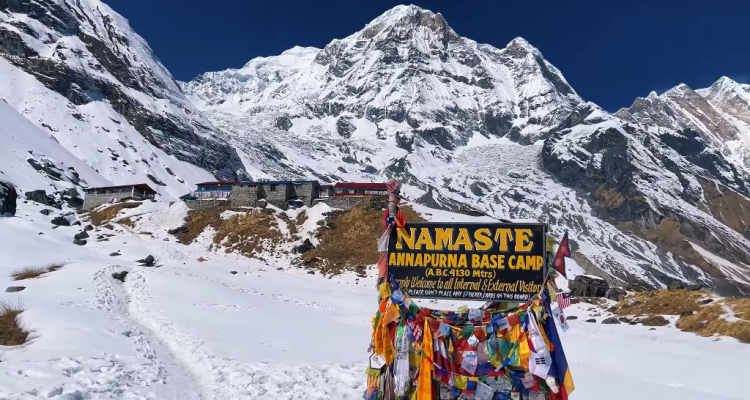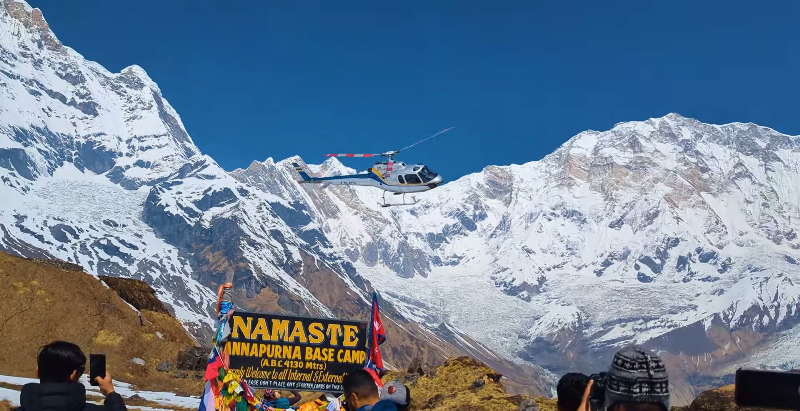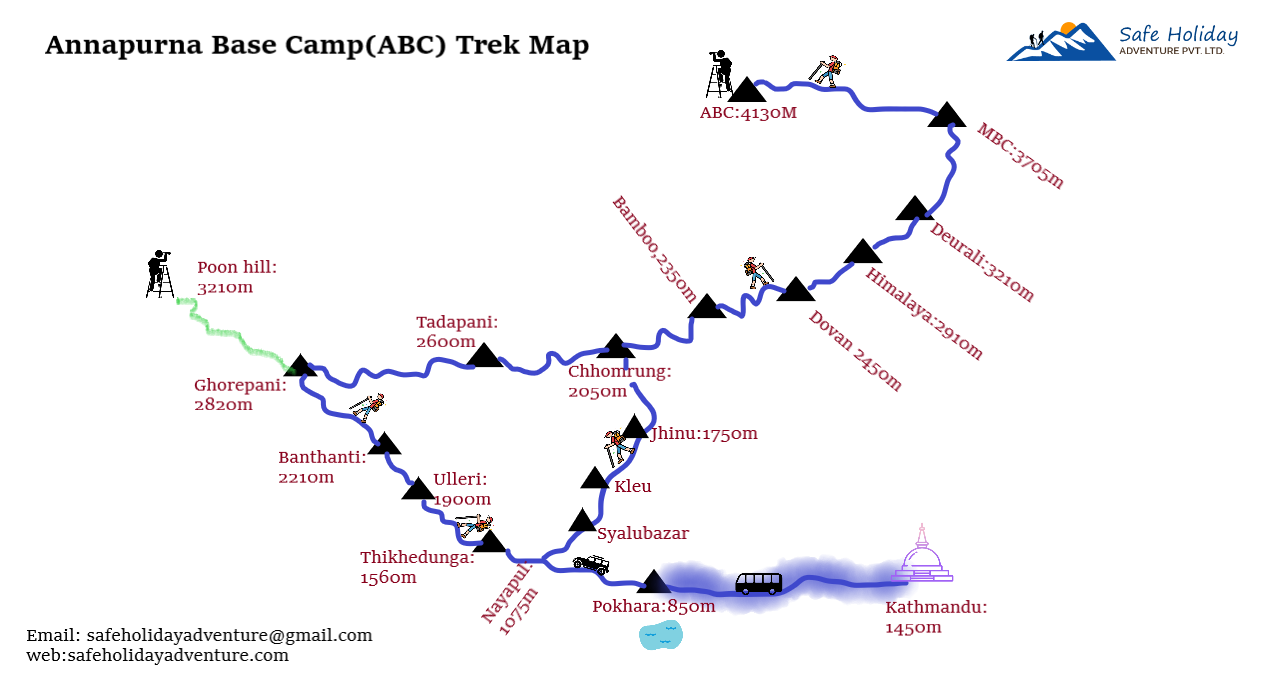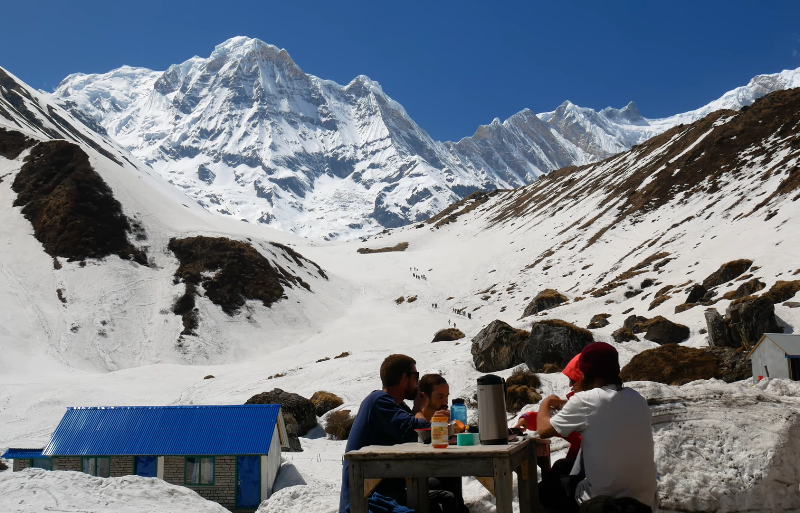January 22, 2024

The Annapurna Base Camp (ABC) trek is a mesmerizing journey through the spectacular landscapes of the Annapurna region in Nepal. The trek typically takes around 7 to 12 days, depending on the chosen route and pace. The adventure begins in either Pokhara or Kathmandu, with most trekkers opting for a bus or private vehicle to Nayapul, the starting point of the trek.
The best time to embark on the ABC trek is during the pre-monsoon (spring) and post-monsoon (autumn) seasons, which are generally from March to May and September to November. During these periods, the weather is favorable with clear skies and moderate temperatures, offering breathtaking views of the surrounding peaks.
On this trek, trekkers are treated to a diverse range of scenery, from lush terraced fields and quaint villages to rhododendron forests and high-altitude landscapes. The trek also provides stunning panoramic views of iconic Himalayan peaks, including Annapurna South, Annapurna I, Machapuchare, and Hiunchuli.
Accommodation along the trail consists of teahouses, providing basic yet comfortable lodging. These teahouses also offer a variety of meals, with options such as dal bhat (lentil soup with rice), noodles, and local specialties. It’s advisable to carry some snacks and a water purifier, as bottled water becomes scarcer and more expensive at higher elevations.
While the trek is considered moderate, there are challenging sections, especially as you ascend higher. Altitude can be a concern, so acclimatization days are incorporated into the itinerary to help prevent altitude sickness. Hiring a local guide and porter is recommended, not only for assistance with navigation and carrying heavy loads but also for a richer cultural experience as they share insights into the local way of life.

Start of the Winter Trek at Annapurna Base Camp.
The Annapurna Base Camp (ABC) trek in Nepal is a popular trekking destination, and the optimal timing for the trek depends on the season and weather conditions. The two main trekking seasons in the Annapurna region are the pre-monsoon (spring) and post-monsoon (autumn) seasons.
Keep in mind that weather conditions can vary, and it’s essential to check updated weather forecasts before embarking on the trek. Additionally, the popularity of the Annapurna Base Camp trek means that tea houses and accommodations may get crowded during peak seasons, so it’s advisable to book in advance.
Ultimately, the best time for the Annapurna Base Camp trek depends on your preferences, whether you prefer blooming flowers in spring or lush landscapes in autumn.
Embarking on the breathtaking Annapurna Base Camp trek is an exhilarating adventure that demands careful financial planning. The cost of this trek depends on various factors, and understanding these elements is crucial for budget management.
The trek duration plays a pivotal role in determining expenses. A minimum of 6 days is required for a standard journey, while those less physically fit or opting for shortcuts might need 7 or 8 days. Choosing the classic route through Ghorepani Poon Hill extends the trek to 10-11 days. The number of guides and porters, group size, accommodation standards, and transportation options further influence costs. Trekkers can tailor their choices based on preferences and financial constraints.
For a 6-day all-inclusive package, budgeting around $500-600 USD per person is reasonable. If opting for a 7-8 day package due to fitness concerns or shortcut preferences, the estimated cost rises to $600-700 USD per person. The classic route, which includes Ghorepani Poon Hill and spans 10-11 days, typically costs $750 USD and above.
Effective budget management involves making informed choices at every stage of the trek. Trekkers should consider sharing guide and porter costs with a group to minimize individual expenses. Careful selection of accommodations, balancing comfort and budget, is essential. Additionally, comparing transportation options and opting for a suitable mix of private and public transport can significantly impact overall costs. Packing wisely to avoid unnecessary expenses on the trail is also advisable.
In conclusion, the Annapurna Base Camp trek promises an unforgettable journey through stunning landscapes, and strategic financial planning ensures that this adventure remains accessible to a wide range of enthusiasts. By understanding and considering the various cost factors, trekkers can strike a balance between a fulfilling experience and budgetary constraints.
Annapurna Base Camp Trek for Nepali trekkers cost:
The approximate cost for Nepali individuals embarking on the Annapurna Base Camp trek is NPR 3,000 per person per day. Therefore, for a 5-day journey to the Annapurna Base Camp, the total cost would be around NPR 15,000 per person, excluding gear and accommodations in Pokhara.
For those new to trekking who need to purchase essential gear such as trekking bags, boots, trousers, hats, gloves, and other items, an additional expenditure of approximately NPR 10,000 to 15,000 may be incurred. While high-end gear can be more expensive, reliable options can be found in Thamel, Kathmandu.
Other factors contributing to the overall cost include accommodations in Pokhara and transportation, the expenses of which vary depending on personal preferences. In summary, the Annapurna Base Camp trek cost for Nepali individuals is estimated to be around NPR 30,000, give or take. Traveling in a larger group may result in reduced costs. This covers basic food and accommodation, but for those desiring a more luxurious experience akin to foreign tourists, the cost increases to $35 per day.

Annapurna base camp trek map from Kathmandu
You can find various types of maps for the Annapurna Base Camp trek in Nepal or your own country. Different companies publish these maps, and two well-known ones in Nepal are Nepal Map House and Himalayan Map House. The larger the map you choose, the more expensive it may be. We recommend getting a compact, foldable map that can easily fit in your bag or pocket. If you book your trip with us, you can receive a free Annapurna Base Camp trek map when you arrive in Nepal on your trip preparation day.
In addition to traditional paper maps, nowadays, there are many useful apps available for the Annapurna Base Camp trek. These apps can show you various details such as altitude, heartbeat, mountain names, distance, and more. Smartwatches, in particular, can be handy for accessing this information on the go. So, if you prefer digital options over paper maps, there are plenty of choices to enhance your trekking experience.
Starting Point: Kande or Phedi
Description: You begin your ABC trek by driving from Pokhara to either Kande or Phedi. From there, the trek takes off, offering beautiful landscapes and a gradual ascent. This route is relatively direct, making it a good choice for those who prefer a shorter drive before starting the trek.
Embark on a scenic drive from Pokhara to Kande or Phedi, a journey of about an hour and 30 minutes, respectively. From these gateways, a trek unfolds through picturesque landscapes, leading to charming villages like Australian Camp, Pothana, and Dhampus, nestled amid enchanting forests. The proximity of Kande and Phedi offers flexibility in choosing your starting point. With 6-7 days to spare, dive into the captivating adventure of the Annapurna Base Camp trek, commencing from either Kande or Phedi. This immersive journey promises a blend of cultural encounters and natural beauty, making it an ideal escape for those seeking a week-long trekking experience from the heart of Pokhara.

at MBC during ABC trek
Starting Point: Nayapul
Description: This option involves a drive from Pokhara to Nayapul, the starting point of your trek. Nayapul is a vibrant town, and the trail from here takes you through charming villages and scenic terrain. This route provides a diverse trekking experience with various landscapes and local encounters.
Embarking on the epic Annapurna Base Camp trek commences at Nayapul, a bustling gateway that has welcomed trekkers for years. This classic route through Ghorepani unfolds over 10-11 days, promising a journey through captivating landscapes. Nayapul, resembling a vibrant trade hub, marks the initiation of an awe-inspiring adventure. The trail weaves through diverse terrains, from quaint villages to lush forests, culminating in the majestic Annapurna Base Camp. Beyond a mere physical endeavor, the trek unveils a cultural and natural immersion over days, creating an experience as enriching as it is awe-inspiring. Prepare to be captivated by the Himalayan wonders along this iconic and time-honored ABC trail, starting your trekking odyssey from Nayapul.
Starting Point: Jhinu
Description:
Embark on an exhilarating journey from Pokhara to Jhinu, a scenic drive that unfolds a mesmerizing tapestry of landscapes and cultural richness. The initial leg of your adventure spans a delightful three hours, with the first hour guiding you along smooth and well-maintained roads, setting the stage for the picturesque expedition that lies ahead.
As you leave Pokhara behind, the road meanders gracefully, revealing breathtaking views of the surrounding hills and valleys. The air is crisp, filled with the essence of the lush greenery that blankets the terrain. The first hour treats you to a smooth ride, allowing you to appreciate the natural beauty that Nepal is renowned for.
Prepare yourself for a transition, as the next phase of the journey introduces you to the heart of local life. The road transforms into an offbeat trail, winding its way through quaint villages that seem frozen in time. The vibrant colors of traditional Nepalese architecture greet you, offering a glimpse into the cultural richness of the region.
As you navigate through these charming villages, the Modi River becomes a constant companion, its gentle flow reflecting the serenity of the surroundings. The journey becomes an immersive experience, where each turn unravels new vistas, and every village showcases the warmth of local hospitality.
The backdrop evolves dramatically, unveiling terraced fields that cascade down the hillsides like steps to nature’s grandeur. The symphony of vibrant greens and golden hues against the backdrop of the Modi River creates a visual masterpiece, etching memories that linger long after the journey concludes.
The crown jewel of this adventure is the backdrop of snow-capped mountains that gradually reveals itself on the horizon. Majestic peaks stand tall, their icy summits glistening in the sunlight. The juxtaposition of traditional village life and the awe-inspiring grandeur of the Himalayas creates a tapestry of contrasts that is both humbling and awe-inspiring.
In those three hours, the drive from Pokhara to Jhinu becomes more than just a commute—it transforms into a soul-stirring experience. It’s a voyage through time, culture, and nature, leaving you with indelible memories of a road less traveled and a landscape unlike any other.
Starting Point: Ulleri
Description: This option combines a scenic drive to Ulleri with a trek through the famous Ghorepani. Ulleri is known for its stone-paved steps, and the trail leads you through lush rhododendron forests. Ghorepani offers stunning sunrise views over the Annapurna and Dhaulagiri mountain ranges, adding an extra layer of beauty to your journey.
Embark on the famed Ghorepani Poon Hill trek, starting with a scenic 3-hour drive from Pokhara to Ulleri. This budget-friendly option completes the enchanting circuit in just 4 days. Ulleri, a vibrant Magar village, offers a glimpse into local life with traditional houses, a school, temple, and church, set against the backdrop of stunning rhododendron forests. The trek blends cultural richness and natural splendor, making it an ideal choice for those short on time. As you traverse this picturesque route, you’ll witness the seamless integration of tradition and nature, creating a memorable and efficient trekking experience in the heart of the Annapurna region.
Each option has its unique charm, and your choice depends on your preferences for travel time, scenery, and overall experience. Enjoy your trek to Annapurna Base Camp!
Day 1: Drive from Pokhara to Kande, Trek to Tolka
Pokhara: 827 meters (2,713 feet)
Kande: 1,700 meters (5,577 feet)
Tolka: 1,700 meters (5,577 feet)
Day 2: Tolka to Lower Sinuwa
Tolka: 1,700 meters (5,577 feet)
Lower Sinuwa: 2,340 meters (7,677 feet)
Day 3: Sinuwa to Deurali
Lower Sinuwa: 2,340 meters (7,677 feet)
Deurali: 3,230 meters (10,597 feet)
Day 4: Deurali to Annapurna Base Camp (ABC)
Deurali: 3,230 meters (10,597 feet)
Annapurna Base Camp (ABC): 4,130 meters (13,550 feet)
Day 5: ABC to Lower Sinuwa
Annapurna Base Camp (ABC): 4,130 meters (13,550 feet)
Lower Sinuwa: 2,340 meters (7,677 feet)
Day 6: Sinuwa to Jhinu, Drive to Pokhara
Lower Sinuwa: 2,340 meters (7,677 feet)
Jhinu: 1,780 meters (5,840 feet)
Pokhara: 827 meters (2,713 feet)
Day 1: Drive from Pokhara to Nayapul, Trek to Jhinu Danda
Pokhara: 827 meters (2,713 feet)
Nayapul: 1,070 meters (3,510 feet)
Jhinu Danda: 1,760 meters (5,774 feet)
Day 2: Jhinu Danda to Bamboo
Jhinu Danda: 1,760 meters (5,774 feet)
Bamboo: 2,335 meters (7,660 feet)
Day 3: Bamboo to Deurali
Bamboo: 2,335 meters (7,660 feet)
Deurali: 3,230 meters (10,597 feet)
Day 4: Deurali to Annapurna Base Camp (ABC)
Deurali: 3,230 meters (10,597 feet)
Annapurna Base Camp (ABC): 4,130 meters (13,550 feet)
Day 5: ABC to Sinuwa
Annapurna Base Camp (ABC): 4,130 meters (13,550 feet)
Sinuwa: 2,340 meters (7,677 feet)
Day 6: Sinuwa to Jhinu Danda
Sinuwa: 2,340 meters (7,677 feet)
Jhinu Danda: 1,760 meters (5,774 feet)
Day 7: Jhinu Danda to Nayapul, Drive to Pokhara
Jhinu Danda: 1,760 meters (5,774 feet)
Nayapul: 1,070 meters (3,510 feet)
Pokhara: 827 meters (2,713 feet)
Day 1: Nayapul to Tikhedhunga
Nayapul: 1,070 meters (3,510 feet)
Tikhedhunga: 1,480 meters (4,856 feet)
Day 2: Tikhedhunga to Ghorepani
Tikhedhunga: 1,480 meters (4,856 feet)
Ghorepani: 2,874 meters (9,426 feet)
Day 3: Ghorepani to Poon Hill and Tadapani
Early morning hike to Poon Hill (3,210 meters/10,531 feet)
Ghorepani: 2,874 meters (9,426 feet)
Tadapani: 2,630 meters (8,629 feet)
Day 4: Tadapani to Chhomrong
Tadapani: 2,630 meters (8,629 feet)
Chhomrong: 2,170 meters (7,119 feet)
Day 5: Chhomrong to Bamboo
Chhomrong: 2,170 meters (7,119 feet)
Bamboo: 2,335 meters (7,660 feet)
Day 6: Bamboo to Deurali
Bamboo: 2,335 meters (7,660 feet)
Deurali: 3,230 meters (10,597 feet)
Day 7: Deurali to Annapurna Base Camp (ABC)
Deurali: 3,230 meters (10,597 feet)
Annapurna Base Camp (ABC): 4,130 meters (13,550 feet)
Day 8: ABC to Bamboo
Annapurna Base Camp (ABC): 4,130 meters (13,550 feet)
Bamboo: 2,335 meters (7,660 feet)
Day 9: Bamboo to Jhinu Danda
Bamboo: 2,335 meters (7,660 feet)
Jhinu Danda: 1,760 meters (5,774 feet)
Day 10: Jhinu Danda to Landruk, Phedi, and Drive to Pokhara
Jhinu Danda: 1,760 meters (5,774 feet)
Landruk: 1,646 meters (5,400 feet)
Phedi: 1,130 meters (3,707 feet)
Drive back to Pokhara
Group Discounted Cost/Prices
No of People Silver Price P.P
👉 1 – 1 US$ 770
👉 2 – 3 US$ 488
👉 4 – 6 US$ 475
👉 7 – 9 US$ 460
👉 10 – 12 US$ 450
✨ Bronze Price: US$ 285
🌟 Silver Price: US$ 488
🏔️ Gold Price: US$ 584
What’s Included:
What’s Not Included:

Preparing for the Annapurna Base Camp trek requires careful consideration and planning. To embark on this adventure, start by assessing your ability to undertake such a trek. Familiarize yourself with the trek grade to gauge the level of difficulty. Additionally, it’s crucial to have a basic understanding of Altitude Mountain Sickness, as this knowledge can prove invaluable in the mountainous terrain.
Obtaining a tourist visa for Nepal is a straightforward process, available either in your home country or upon arrival in Nepal. Before setting foot in Nepal, it’s advisable to compile a comprehensive packing list tailored to your trek. Keep in mind that certain brands may not be readily available in Nepal.
For your convenience, here’s a suggested packing list for trekking in Nepal. Note that not all items are mandatory, and you can prioritize based on your specific needs:
Avalanche awareness is crucial when trekking in mountainous regions like the Annapurna Base Camp trek. Here are some tips to help you stay safe and informed about avalanche risks:
Stay updated on weather forecasts before and during your trek.
Avoid trekking during heavy snowfall or when avalanche warnings are in place.
Learn about avalanche risk factors, such as snow conditions, slope angles, and weather patterns.
Familiarize yourself with the signs of potential avalanches, such as recent avalanches, cracking sounds in the snow, and visible loading on slopes.
Plan your trek during the safer seasons, typically autumn (September to November) or spring (March to May).
Avoid peak winter when snowfall is heavy, increasing the risk of avalanches.
Hire a local guide who is familiar with the area and its specific avalanche risks.
Listen to the advice of experienced guides and locals who understand the mountain conditions.
Always carry avalanche safety gear, including a transceiver, probe, and shovel.
Ensure you know how to use the equipment properly, and practice with it before the trek.
Trekking in a group enhances safety, as members can assist each other in case of an emergency.
Keep an eye on your group members and communicate openly about the conditions.
Avoid steep slopes, especially those with a slope angle greater than 30 degrees.
Be cautious around convex slopes, cornices, and areas prone to wind loading.
Stick to well-established trekking trails, as these are less likely to be avalanche-prone.
Deviating from the path may lead you into risky terrain.
Develop an emergency response plan with your group, including communication procedures and evacuation routes.
Know the location of the nearest emergency services and communicate your itinerary to someone reliable.
Keep a constant eye on the changing weather and snow conditions.
Stay updated with local authorities, guides, and other trekkers about the current situation.
Remember, safety should be your top priority. If you’re uncertain about the conditions or face unexpected challenges, consider turning back or seeking assistance. It’s always better to prioritize safety over reaching your destination.
Similar topic you may like for detail information: